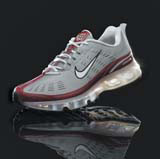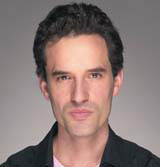Finger on the swoosh
As Nike makes history with its product designer chief executive, Mike Exon asks if more designers can aspire to have power in the boardroom.

As Nike makes history with its product designer chief executive, Mike Exon asks if more designers can aspire to have power in the boardroom
You’d be forgiven for missing the significance of Mark Parker’s promotion at Nike last week. Most of the international business press didn’t dwell on the fact that the incoming Nike chief executive is a designer. Not that the 50-year-old former distance-runner does much shoe designing these days, but that hasn’t stopped him from becoming one of the most high-powered advocates for design in business, just about anywhere on the planet.
When I met him four years ago, it quickly became clear that Parker was not the sort of self-serving megalomaniac you’d expect at the top of a £7bn consumer business. Rather quiet, in fact, he comes across as thoughtful, a good listener, keen to talk ideas and still very much the designer at heart. The story goes that whenever he travelled on business, Parker would seek out the weirdest little shops in town, not just to keep an eye on street culture, but to augment his tin toy and street art collections. It’s hardly surprising that the man who describes his promotion as ‘humbling’ envisages taking a ‘different management style’ to his predecessor Bill Perez, from SC Johnson.
Maybe it was his creative sensibility that saw Parker overlooked for the top job when Nike founder Phil Knight stepped down as chief executive at the end of 2004. City analysts probably don’t think of his kind as chief executive material. But, on Monday, Knight suggested to an assembly of analysts and media representatives that he had made a mistake by not appointing the designer sooner.
Having moved through the ranks over the past 27 years, Parker says he learned the business from its two founders (Knight’s partner was the late Bill Bowerman). As president of brand at Nike, Parker worked directly under Knight for several years and is said to be very close to his mentor. Nike staff even used to call him the company’s ‘number two’.
Design has continued to grow steadily at Nike, says Martin Lotti, the designer behind Nike’s Air Max 360, launched last week. ‘Right now we are working on our 2007 and early 2008 designs for the Olympics in Beijing, which is really exciting, but I can’t say

too much about it.’ When Parker worked on the Air Max 1 in 1987, the shoes could feature several iterations of the ‘swoosh’. But Nike now treats the marque as pretty sacred; there’s now just one version.
As a global creative director, Lotti (pictured right) also heads up the design of Nike’s women’s footwear. He says Nike continues to operate under four main design divisions: footwear, apparel, equipment and brand identity. There are 400 in-house designers at its headquarters in Beaverton, Oregon.
In his previous role, Parker was comparable to, say, Jonathan Ive at Apple, or J Mays at Ford – high-powered senior vice-presidents both – who not only champion in-house design, but who see to it that design and branding drive business strategy. As chief executive, though, his only real compatriots in big business, now, are the likes of Steve Jobs and Richard Branson – who head of design at Orange Clive Grinyer calls the ‘non-designer’ designers.
Parker’s arrival at the top of big business has huge significance for the design world. It forces a re-assessment of the age-old convention that creatives should not be let loose in the boardroom. This test case at Nike will illustrate what can be done when a designer is given the opportunity and responsibility, adds Grinyer.
‘It’s incredible, really, that companies want strong brands and yet have someone like an accountant to run their businesses,’ he says. ‘They are not the people in touch with the customers.’
Designers understand intrinsically about growing demand through design and innovation, which may be why Knight says, ‘Mark Parker brings more tools to this job than anyone in this industry ever had.’ Parker was quick to stress that Nike remains a ‘growth’ company, though. ‘The heart and soul of our company is product performance and innovation. Next to innovation, it is building compelling connections and relationships with our consumers,’ he asserts.
Knight clearly feels it is time to concentrate on growing Nike’s existing business organically, rather than through acquisition, which is perhaps where an innovator, such as Parker, can come into his own. Nike has ‘a full plate right now and managing the brands we have is one of the hardest and most promising of management tasks,’ says Knight.

But a number of challenges face Parker (pictured left) going forward, before he can prove himself a capable chief executive. Maintaining Nike’s growth record will be increasingly challenging, as global sales of sports shoes and apparel flatten out. Then there is the question of whether Parker can manage the business, without being swamped by its biggest shareholder. Knight still has his hands firmly on the buttons at Nike, as we have seen from recent events – he has stated that it was he who called on Perez to resign and who nominated Parker to the board as his replacement.
At 67 years old, though, Knight must be keen to secure his legacy. Wouldn’t it be interesting if it weren’t the accountant or the salesman running the next phase of the Nike project, but the designer?
Nike Swoosh:
Carolyn Davidson is not one of the great names you naturally associate with the world of brand design. But, 30 years ago, the graphic designer from Portland State University put the finishing touches to the Nike ‘swoosh’. It was pivotal to the relaunch of her client, the then Blue Ribbon Sports. She sold her design for just $35.
Nike Air Max 360:
• Designed by Martin Lotti
• Claimed to be the first running shoe to use a 100 per cent air-cushioned sole
• Based on Mark Parker’s Air Max 1, the first shoe to expose the air cushion unit
-
Post a comment



